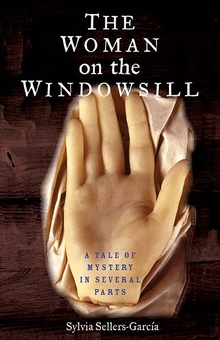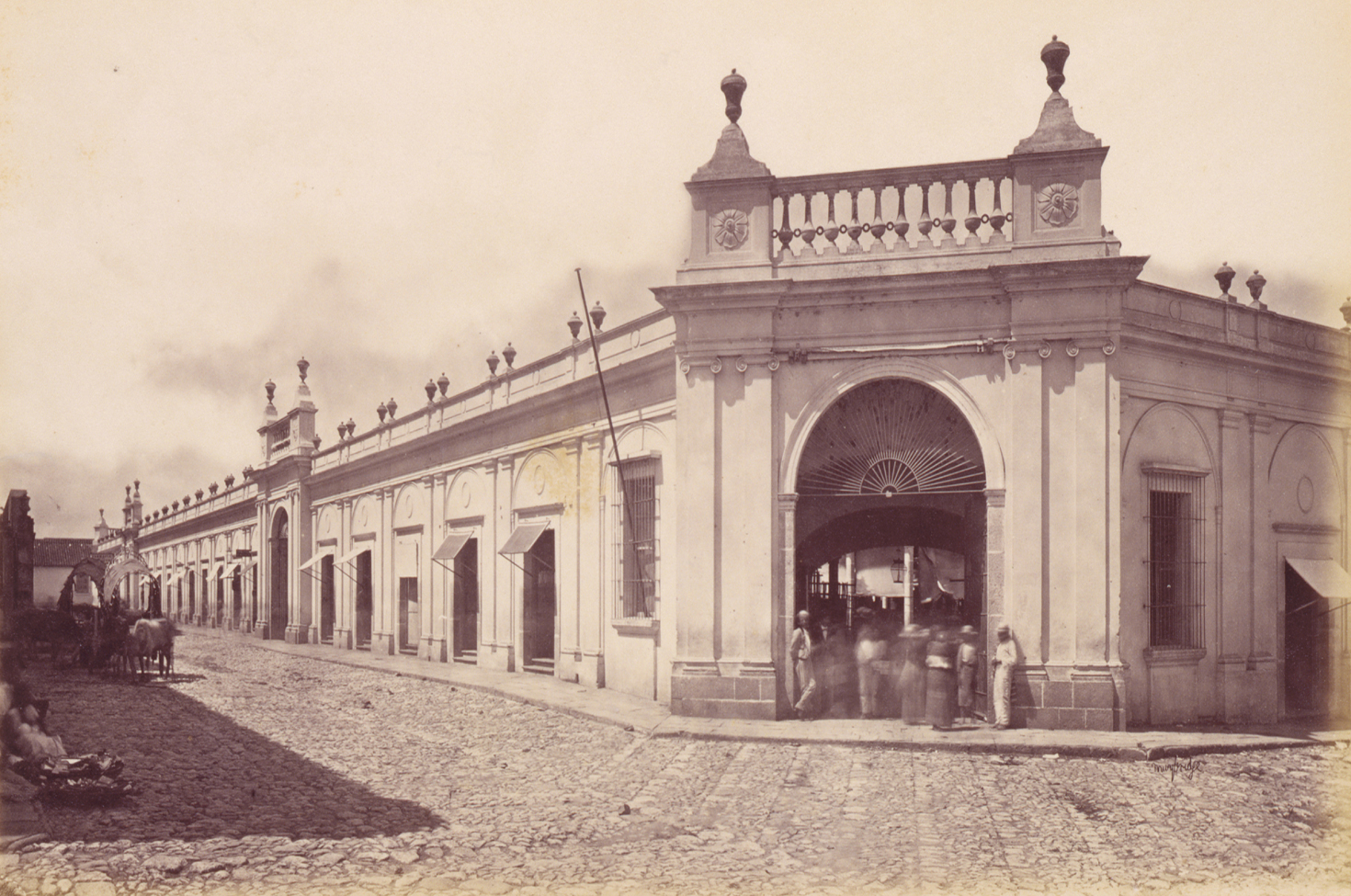
Public Market, Guatemala, by Eadweard Muybridge, 1875. Smithsonian American Art Museum, Gift of Mary and Dan Solomon, 1997.
Every murder mystery begins with a body. Or it begins with calm, an impression of serenity that promises to shatter at any moment, when the wreckage of a human life is finally revealed. A corpse. A long enmity. A sudden flash of brutality. The disruption of that initial serenity, manifested in death. Since the body that begins this story is never found, the mystery must begin with calm.
It is the first of July in 1800, shortly after six in the morning. Despite the early hour, there is already movement. Servants have risen to make breakfast. The clap of hands against wet maize dough and the crackle of stove fires mix with slow morning conversations: gossip, last night’s dreams recounted and interpreted, plans made for the day. Some have already left the house to run early errands, and their bare feet patter on the street stones. The zanate birds are loud at this hour, clicking and croaking into the humid air.
Don Cayetano Díaz, a reputable surveyor and mapmaker, opens the study window of his well-appointed home in Guatemala City. The shutters, as with all buildings in this colonial capital, open onto the street, where wide stone sills offer perfect vantage points for watching passersby. Díaz does this every day. He opens the shutters and then settles down to work at the desk that sits just below the window. On this morning, he realizes at once that something is different. There is a strange object on his sill. He calls to his brother, for already the object seems ominous. There are drops of blood on the sill’s cold gray stone.
Díaz’s brother hurries from the house to seek a surgeon, Don Josef Thomas Caseros, and as they return, coincidentally, Díaz sees another acquaintance passing by the window and calls him into the house. Don Narciso Esparragosa, one of the most renowned surgeons in Guatemala—indeed, a leading figure of Enlightenment medicine in Spanish America—is making his way to the nearby hospital. Together, the four men examine the object on the windowsill, and now there can be no doubt: placed on a lily pad, as if served on a plate, is a woman’s breast.
Narciso Esparragosa examines it with a surgeon’s eye. In fact, it is not one breast, but two. They are attached, cut from the body in the shape of an hourglass; the one with less skin has been folded beneath the other. At the other end, the skin extends all the way to the underarm, with its scrap of dark hair.
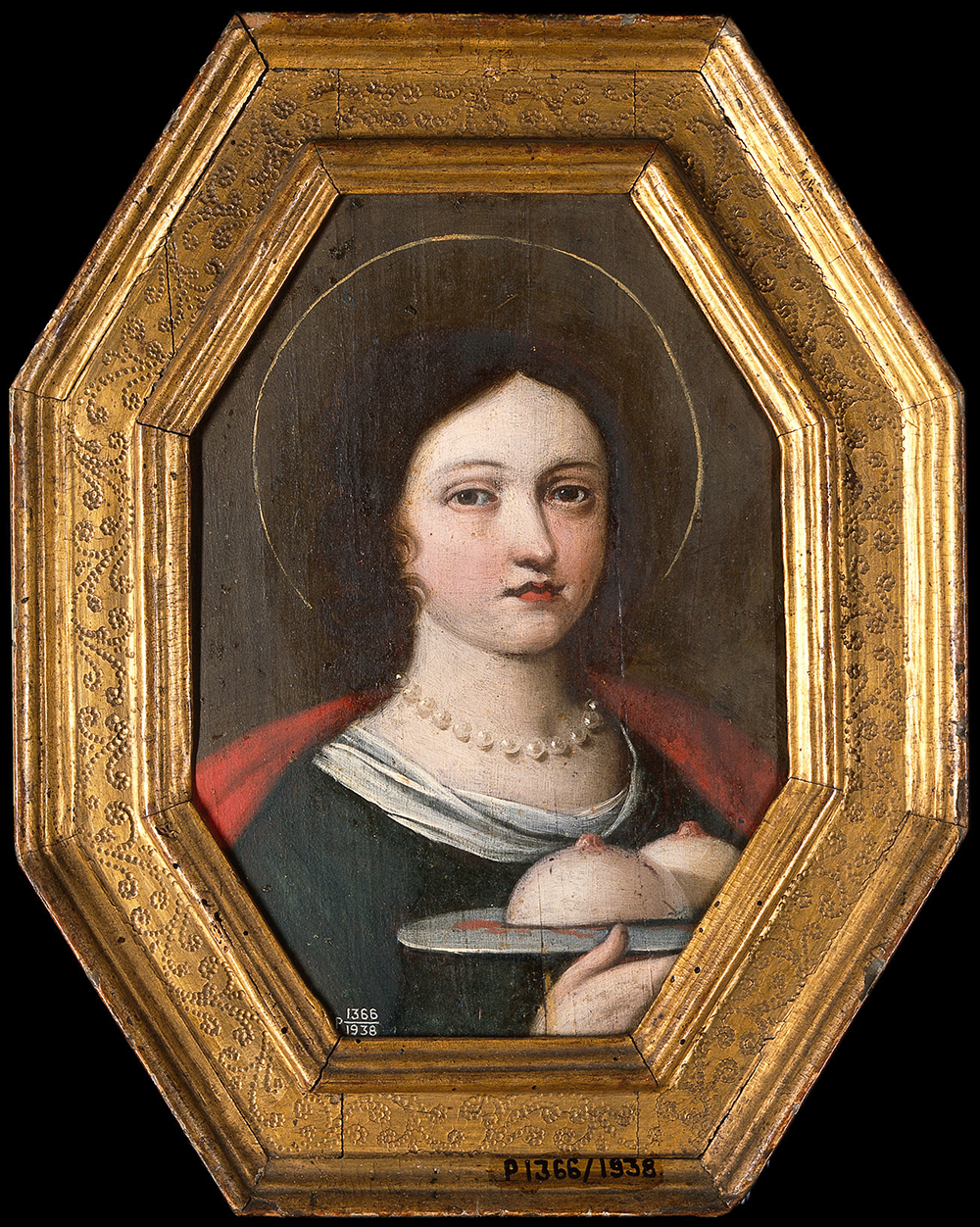
Narciso Esparragosa believes that the cut reveals no expert skill, and he states that he cannot fathom what has prompted someone to do such a thing. None of them can fathom it. They do not understand it; but they do understand that this is a criminal act. A deeply offensive and disturbing criminal act. The evidence must be recorded, and the authorities must be called. The court escribano (scribe and notary), Vicente Antonio de Villatoro, makes his own examination of the breasts, describing them in as much detail as possible. He notes four drops of blood on the sill. He notes a severed nerve and small discolorations of the skin. And he speculates, because of the darkened areolas, that the woman had been pregnant.
It is only because of the coincidence of Cayetano Díaz’s skill as a mapmaker that we, readers in the present day, have a visual impression of what he saw on the morning of July 1, 1800. Illustrations in criminal cases of this period are very rare. But Díaz had the colored pencils he used for his meticulous drawings of land parcels close at hand, and one of the officials in attendance must have realized that he was uniquely suited to depicting this most unimaginable piece of evidence. His illustration of the severed breasts appears on the second page of the voluminous records for the criminal trial that ensued once the authorities were called and the investigation had begun.
Díaz made a careful drawing, with such precision in the depiction of the rounded breast, the tuft of hair, the incongruous lily pad, that the subject becomes unrecognizable in its verisimilitude. We never see the body this way: mutilated, disembodied. And viewed aerially, like terrain on a map. When I first saw this drawing in the archive in Guatemala City, I was flipping through the pages, not reading, and then I stopped: staring at the inscrutable cluster of shapes for several seconds without comprehending.
In fact, not until I had begun reading the case—lured in by the enigmatic drawing in the margin—did I understand what it depicted, and the horror dawned on me retrospectively. This is what it looked like. The horror we experience, realizing the fact of these body parts on the windowsill, is in some ways similar to but in most ways different from what people in Guatemala experienced at the time. The fact that Guatemalans were horrified is clear. Action was taken immediately to identify the “owner”—as they put it—of the breasts. More than a dozen people were jailed over the course of the investigation and dozens of testimonies were taken. More than a hundred folios were filled with depositions, orders, correspondence, and speculations on the part of the presiding judges. Bodies were exhumed. The investigation spilled over into nearby towns and villages. A special police patrol was created to lie in wait for the perpetrator. Guatemala City was horrified. But not in the way we are horrified.
We are horrified in a manner trained by long exposure to crimes of this nature—fictional and factual. We have well-established habits of reading and viewing horrific crime, and we have well-established genres on the subject, which are at least partly devoted to spectacularly gruesome acts of violence against women. Through these habits and genres and their depictions of such acts we are trained to be both morally outraged at the misogyny and simultaneously titillated. Sometimes the latter is an explicit aim, but mostly it is concealed, wrapped in the moral outrage as something provoked so that the reader or viewer can understand—and even enjoy—what is being condemned.
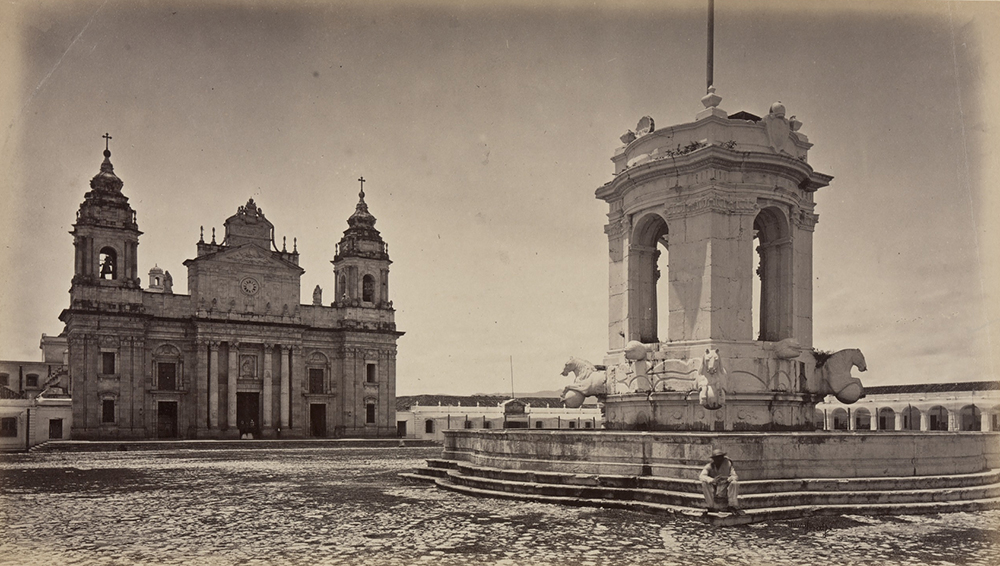
We are also trained, culturally, through exposure to legal codes and expectations about human rights. We have a particular understanding of the idea of the “victim.” However unpleasant it was for Cayetano Díaz to be singled out, clearly the party most wronged in this case was the woman: that missing woman so terribly separated from a part of herself. To us, she is equally a victim regardless of age, class, or race.
And less obviously, we are also trained to understand specific acts of violence as meaning certain things. Machine-gun fire sprayed across a city street is not the same as a single stab to the back in a suburban kitchen, which is not the same as an elaborate death by many cuts under a freeway. We have our own language, with its precise vocabulary, of violence. In all these ways, Guatemalans perceived this event and experienced horror differently. To begin with, not everyone could be construed equally as a victim. Only certain people could be the victims of certain kinds of crimes. While in some cases the laws did make formal distinctions, the most powerful distinctions were cultural. It was understood that an Indian servant woman could not really be raped. It was understood that a low-class mulato man could not really be insulted. These severed breasts, identified as nonwhite, spoke immediately to viewers about the potential wrongs the woman was eligible to suffer.
In the early hours of July 1, 1800, the authorities took a number of steps in swift succession. The breasts were transported to the cabildo, the city council’s offices, so that anyone in the city might view them and perhaps identify them. Next, authorities in every section of the city and in the nearby towns were notified to be on the lookout for a woman’s corpse. Further, permission was requested from the archbishop to exhume any bodies buried on sacred ground since June 30. And last of all, the authorities went in person—accompanied by a large group of people—to search the area deemed most likely to yield the body with its missing breasts.
These proceedings give us a sense of how significant this incident seemed. The city paused. Its attention shifted. People stopped what they were doing, and they attended to this remarkable event. They wanted to be a part of it.
We are lucky that the case of the severed breasts is readable. There are frustrating silences and maddening dead ends, but the words themselves are mostly legible. Documents at the Archivo General de Centro América, the AGCA in Guatemala City, are kept in bundles—legajos—tied with string. You find the string, like the documents, in varying stages of decay. Sometimes the documents have all their edges, they have been sewn together carefully, and they make fairly tidy stacks inside the bundles. More often the documents show evidence of the journey they have taken through the centuries: rats and worms have left strange holes and ragged indentations, water stains bloom across the pages like persistent clouds, humidity and rot leave enigmatic discolorations beneath the words.
A document favored by the fates of archival preservation might look like this.
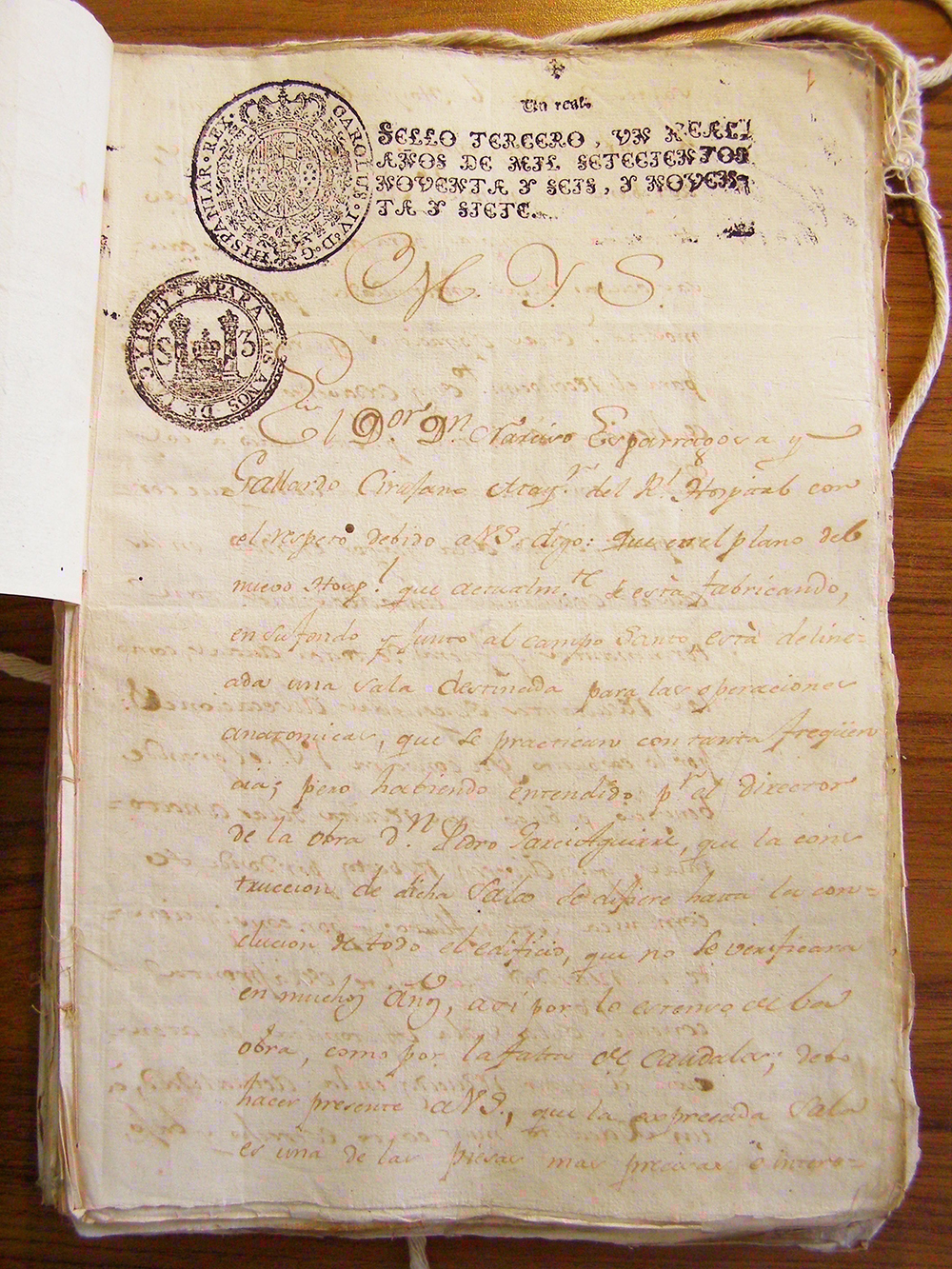
A less fortunate document might look like this one.
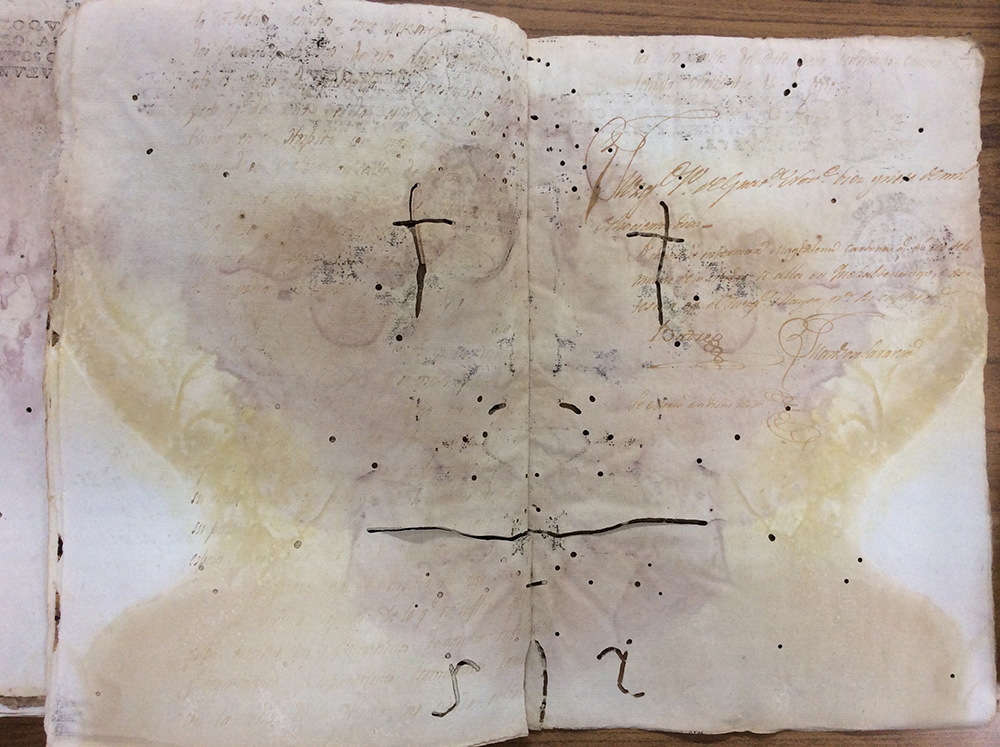
Colonial documents are transporting in a way that contemporary documents are not. Yes, the writing itself looks unfamiliar, and the words describe circumstances far removed from our own. But it is their physical difference that makes you realize, in a manner impossible to ignore, that they belong to an entirely different world.
Confronted with documents like these, you are compelled to think about how they have reached you: how uncertain the path by which the words arrive in the present; how difficult the passage taken by each piece of paper, at once so fragile and so astonishingly durable. Some archivist has brought it out of the vast, dark warren of the stacks (for the AGCA cannot afford bulbs for every aisle of its nine floors), where it has been since Joaquín Pardo, the indefatigable document curator who created the archive’s card catalogue, paged through it in the early twentieth century to record an entry. Before that the document lived in a kind of limbo as it was shuttled from one location to another, perhaps bundled with others of its kind, perhaps loose and half-forgotten. And before that, it might have spent time with a local official who kept the crown’s papers at home (as many officials did), stuffed into a corner or a desk drawer or a family wardrobe.
Then it is a small leap to imagining the original circumstances in which the document was made. A room filled with light from a courtyard door. A scribe bent over the paper; the impassive face of a listening judge; a man or woman seated before them, trying to put into words the way it happened, the way everything suddenly fell apart. Long silences. Touching the paper makes the archive and everything around you seem temporarily insubstantial, as if it is only one more ephemeral stopping point in the document’s journey.
Arlette Farge, in her marvelous exploration of French archival documents from this same period, recounts finding a purse full of seeds among the pages of the case she was consulting. A letter written by a country doctor explained that they came from a young woman who, once a month, discharged the seeds from her breasts. (Yes, I know—breasts seem to be everywhere in the eighteenth century.) Farge recounts debating whether to open the purse and finally making up her mind, then marveling as the seeds poured “down on the yellowed document, as golden as they were on their first day, a brief burst of sunshine.”
I have never found such an extraordinary object, but I do recall finding, in a legal dispute from this period, two love letters confiscated over the course of the proceedings. They were still sealed. Their intended recipients never received them, never read what was inside. I did not open them, but I stared at them a long while, wondering at what had been lost in those closed packets of paper.
The documents I was reading at the AGCA contained a great deal of loss. All were criminal cases from the colonial period, and all connected somehow to acts of violence. After a time, reading such cases carries you past the disorienting surprise of encountering a material fragment of the past. The paper is still shocking in its physicality, but you begin to think about the words and the lives described by the words. You begin to wonder what it means that so many people suffered these losses. Parents losing children, women losing their honor, husbands losing their wives—most often by their own hand. These are only the most obvious losses, the ones directly addressed by the courts’ deliberations. There are others, hazy as the faded water stains, that seem to lie behind the words and are more difficult to discern. A loss of trust between neighbors. A loss of clarity about who belongs. An eroding sense of safety.
Excerpted from The Woman on the Windowsill: A Tale of Mystery in Several Parts, by Sylvia Sellers-García, just published by Yale University Press. Copyright © 2020 by Sylvia Sellers-García. Reprinted by permission of Yale University Press.
